|
A Brief History of
Memotech
Origins
Memotech was founded by Geoff Boyd and Robert Branton, the
two met while they were both at Oxford University.
Robert Branton taught mathematics at Christ Church College and also
worked in Oxford's
Programming Research Group (PRG), part of the
Oxford University Computing Laboratory (OUCL).
Geoff Boyd
studied for a PhD in metallurgy, probably at Wolfson College,
and by 1979 had begun post-doctorate research in the
University’s Engineering Department. During his PhD and research
activities, Boyd had had to design electronic circuits to
support his laboratory work which led to his having a keen
interest in the subject. In an
interview with Audio Amateur in 2013, Boyd said "My exposure
to electronics was as a postgraduate student in the Department
of Metallurgy, Oxford University, where those so inclined built
their own electronics equipment for lab experiments. I took to
this like a duck to water and became quite proficient at
electronics design and construction as well as sheet metal work
for enclosures."
The complimentary skills of Branton (software) and Boyd
(hardware) were ideally suited to a technology based business
partnership and, with financial backing, the two formed
Oxford Computing to produce and market a touch interface
system that they had designed as a replacement for the
ubiquitous qwerty keyboard. The pair's involvement with that
venture was short lived, and when Sinclair Research released the
ZX81 with its measly 1K of Memory, they saw the potential for
expansion RAM packs for the ZX81 and formed Memotech in the
Spring of 1982 to exploit
the opportunity. Not long after the Memotech RAM packs became
available, Sinclair released the ZX Spectrum in the UK, limiting
demand in the UK, resulting in over 70% of Memotech's initial
sales going overseas. When Sinclair had problems supplying their
own 16K RAM packs in the August of 1982, Memotech were able to
fill the void and increase UK sales through the retail chain.
Memotech went on to produce a range of hardware based "Memopaks",
including RAM, RS232 and Centronics interfaces and a High
Resolution Graphics (HRG) adaptor. In addition,
using Branton's software skills, they also produced ROM based
Spread Sheet (MemoCalc), Word Processor (MemoText)
and Z80 Assembler software "Memopaks". By the end
of 1984, some 250,000 Memopaks had been manufactured. (The Home
Computer Advanced Course "Technocrats"
feature in Issue 29 gives an interesting overview of Memotech's
origins.)
The Memotech Computer [Memotech Limited]
In tandem with production of the ZX81 products, Branton and
Boyd had started to develop a low cost, high resolution,
computerised video digitising system they called the
HRX. They had commissioned
Steve Marchant and
Chris Marvell to design the
system, at the heart of it was a 6MHz Z80B computer designed by
Marchant , which he named the "SM1".
Steve Marchant says "Geoff [Boyd] & Robert [Branton] first
got in touch in the late 70s following the publication of an
article in Practical Electronics detailing the design of a
character-based video display unit. At the time I was working on
a PhD at Nottingham Uni.
On the strength of the article they commissioned me to design a
Z80 based computer platform for Memotech [the SM1], which I did.
The SM1 had 64KB of RAM, a pair of 8-inch floppy drives, a
full 80-column colour graphics card and used the CP/M operating
system from Digital Research. The SM1 would have been a very
capable business level machine, but, although a number were made
and used as development machines within Memotech, they were
never offered for sale.
The success of the "Memopak" products had
encouraged Memotech
to invest in land for the construction of a new factory in
Witney, Oxfordshire in order to expand their production
capacity. However, when Sinclair brought out the 48K
ZX Spectrum at the end
of April 1982,
it was clear that the market for memory add-ons was going to
disappear and Memotech's backers decided that they should
refocus the business on the production of their own brand of
micro computer - which would become the
Memotech MTX series.
| While the Station Lane
factory was being built,
Memotech moved into portakabins. (Photo from PCW, 1983) |
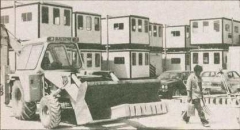 |
| A couple of photos of the inside of the finished
factory, taken from the cover of a Memotech sales
brochure folder. Part of the production area.
(Photos courtesy of Arthur Leigh) |
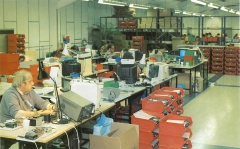 |
| Part of the administration area. Do you
recognise anyone in the photos? |
 |
|
Contemporary photo of the outside of the factory,
showing one of the owners of Norbit Elektronikk
arriving at the factory.
Norbit worked with Memotech
to develop the
prototype for the Super-Toolbox
for the Russian schools bid. |
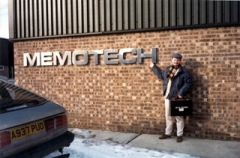 |
| In 2012, the old Memotech factory now looked
like this (Photo courtesy of Google Street View) |
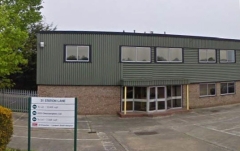 |
| No busier than it was after Memotech moved out,
the factory is once again "For Let". |
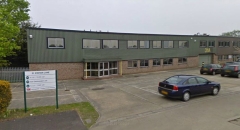 |
Although the SM1 was available, Memotech decided to build on
the relationships that they already had in the home computer
market and to develop a new home computer based on the SM1
design, without the high end subsystems such as the 80 Column
graphics card and disk drives, this allowed the "new" MTX500
computer to be brought to market relatively quickly. The MTX was
pitched at the higher end of the market to compete more with the
BBC Micro than the Sinclair ZX Spectrum. It incorporated a high
quality Video Display Processor (TMS9929A)
with dedicated video RAM, a multi-channel sound chip (SN76489AN),
a high quality BASIC interpreter and built-in Z80 assembler.
[The full specifications are described on my
MTX About page.]
While the "low cost" MTX was intended to target the home
computer market, it retained essential interfaces, such as the
expansion bus connector, to allow it to be upgraded to a
business level machine using functionality from the SM1,
including the 80 Column graphics card and a floppy disk controller that
were needed to run CP/M. These SM1 components were at the heart
of the upgrade paths which were later made available for MTX
owners, such as the FDX
System.
Andy
Key describes how the SM1 was used as a development machine
for MTX software on his
MTX
Development page.
Unfortunately though, by the time that Memotech had entered into
the home computer market, it was already too late. By the time
that the MTX500 became generally available, the market was close
to saturation and it was to peak in 1984. By the end of that
year the home computer market had crashed and the MTX was
effectively already doomed as a commercial product. The last
throw of the dice was an
attempt to win a contract to sell a large number of
computers and disk systems to the Russian school system, when
this failed, Memotech Computers struggled on until the end of
1985 and went into Administration in early 1986. [My
MTX About page describes
the situation on greater detail.]
Memotech Revisited [Memotech Computers
Limited]
Robert Branton had left the company during 1985 as the
financial situation deteriorated and when Memotech Limited folded, Geoff Boyd
acquired the assets of the old company and re-launched
the company as Memotech Computers Limited in February 1986. Boyd
continued to market and support the MTX500, MTX512 and RS128
with the final MTX computer, the
MTX512S2 being
released late in 1986.
The Memotech Video Wall [Memotech Computers
Limited]
With the decline of the home computer market and the monopoly
of the business computer market by the IBM PC & compatibles,
Boyd repositioned the business to market the
Memotech Multi-Effect Video
Wall system - a development of the Memotech HRX described
above.
Memotech were a dominant force in the Video Wall market in
the late '80s and early '90s - supplying the technology for such
high profile installations such as the
Videowall at the Natural History Museum and the original
equipment and system upgrade in 1990 of the Video Wall in the
Hammersmith Palais. Memotech Video Walls were originally
distributed in the UK by Cameron Video Systems, until Memotech
began selling them under the Memotech brand late in the
product's life.
When the video monitor manufacturers such as
Barco were able
to integrate the required Video Wall technology into their
equipment, they could offer complete systems at lower cost than
third party integrators, effectively ending the market for a
separate Video Wall product. The business having run its course,
Memotech Computers Limited was itself formally wound up before
the end of the 1990s.
In the
Audio Amateur interview, of his Memotech days, Geoff,
recalled :-
"At Memotech, we thought all we had to do was produce a
first-class product with a great design and specifications, and
the buyers we had on allocation would come to us. So, we
designed and manufactured the Memotech MTX 512 home computer,
which was launched in 1983. We were competing against [the] BBC
Microcomputer System and never stood a chance in the UK. The
buyers never came and the level of marketing required was beyond
our resources, so our backers eventually pulled the plug in
1986. . . . . I bought what was left of the business and
re-launched Memotech Computers using high-resolution digital
video technology that had been developed at Memotech to a new
market of Video Wall technology. We dominated the supply of
Video Wall controllers for nearly 10 years, from 1986 to 1995. "
Where are they now?
Robert Branton
Geoff Boyd
credits :-
"The
Home Computer Advanced Course", Issue 29, "The Technocrats"
- From the World of
Spectrum archive.
e-mail
from Steve Marchant to Andy Key posted on the
Facebook
Memotech MTX500 Group
Geoff
Boyd,
Interview with Shannon Becker, Audio xpress in April 2013
Popular Computing Weekly, "Street Life", 7th July 1982
http://www.theregister.co.uk - 30 Years On - The Story of
the Memotech MTX, Tony Smith, 28/06/2013
|